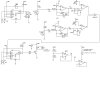hi, iv got to do a project for my electronics course, so i thought id make a mouse trap, using two infrared beams to trigger the door closing mechanism.
it will be a long tube, with the beams at the back, and a trap door at the front held up by a small metal bar. An electro-magnet will be triggered on by the beams. This will pull the bar out of the door dropping it and trapping, hopefully, a mouse.
the electronics for one beam is taken from this site:
**broken link removed**
what i am going to do is: use those circuits. connect this monostable circuit:
http://images.google.co.uk/imgres?i...q=NE555+monostable+circuit&svnum=10&hl=en&lr=
to the output of the detector circuit, then connect a Miniature - Pull Action solenoid (like this: http://rswww.com/cgi-bin/bv/rswww/subRangeAction.do?cacheID=uknetscape)
for pulling the bar from the door.
I need some help with it all though.
Im worried about how to power it atm. it needs to be portable but i really dont know if 4x1.2v batteries, somone said i could use, will be enough for all this as the first link (IR circuits) indicates the use of a dual power supply (+12V, 0V, -12V) while Id have +4.8V and 0V from the battery only and also mine is powering a magnet.
another thing is, iv never used solenoids before, how do you connect them? and i cannot see anywhere on the monostable circuit that i can connect the output of the detector circuit too..
My last question is about the 2 beam settup. Will the 555timer be able to supply 2 IR diodes. i was told to look at the data sheet and see how much current the device can supply, and see how much an IR diode consumes, but when i looked, i cant remmeber the exact figures, but it made out that the 555 time wouldnt even be able to supply one diode. i know for a fact it can thought because iv build the ir circuit before with 1 IR diode and it worked fine. Can anyone help here? and tell me how to connect them and do ill need 2 phototransistors also wont i? how will i connect them and will they affect the circuit also
thnx very much for taking the time to read all this and any help u can provide is greatly appreciated
it will be a long tube, with the beams at the back, and a trap door at the front held up by a small metal bar. An electro-magnet will be triggered on by the beams. This will pull the bar out of the door dropping it and trapping, hopefully, a mouse.
the electronics for one beam is taken from this site:
**broken link removed**
what i am going to do is: use those circuits. connect this monostable circuit:
http://images.google.co.uk/imgres?i...q=NE555+monostable+circuit&svnum=10&hl=en&lr=
to the output of the detector circuit, then connect a Miniature - Pull Action solenoid (like this: http://rswww.com/cgi-bin/bv/rswww/subRangeAction.do?cacheID=uknetscape)
for pulling the bar from the door.
I need some help with it all though.
Im worried about how to power it atm. it needs to be portable but i really dont know if 4x1.2v batteries, somone said i could use, will be enough for all this as the first link (IR circuits) indicates the use of a dual power supply (+12V, 0V, -12V) while Id have +4.8V and 0V from the battery only and also mine is powering a magnet.
another thing is, iv never used solenoids before, how do you connect them? and i cannot see anywhere on the monostable circuit that i can connect the output of the detector circuit too..
My last question is about the 2 beam settup. Will the 555timer be able to supply 2 IR diodes. i was told to look at the data sheet and see how much current the device can supply, and see how much an IR diode consumes, but when i looked, i cant remmeber the exact figures, but it made out that the 555 time wouldnt even be able to supply one diode. i know for a fact it can thought because iv build the ir circuit before with 1 IR diode and it worked fine. Can anyone help here? and tell me how to connect them and do ill need 2 phototransistors also wont i? how will i connect them and will they affect the circuit also
thnx very much for taking the time to read all this and any help u can provide is greatly appreciated


